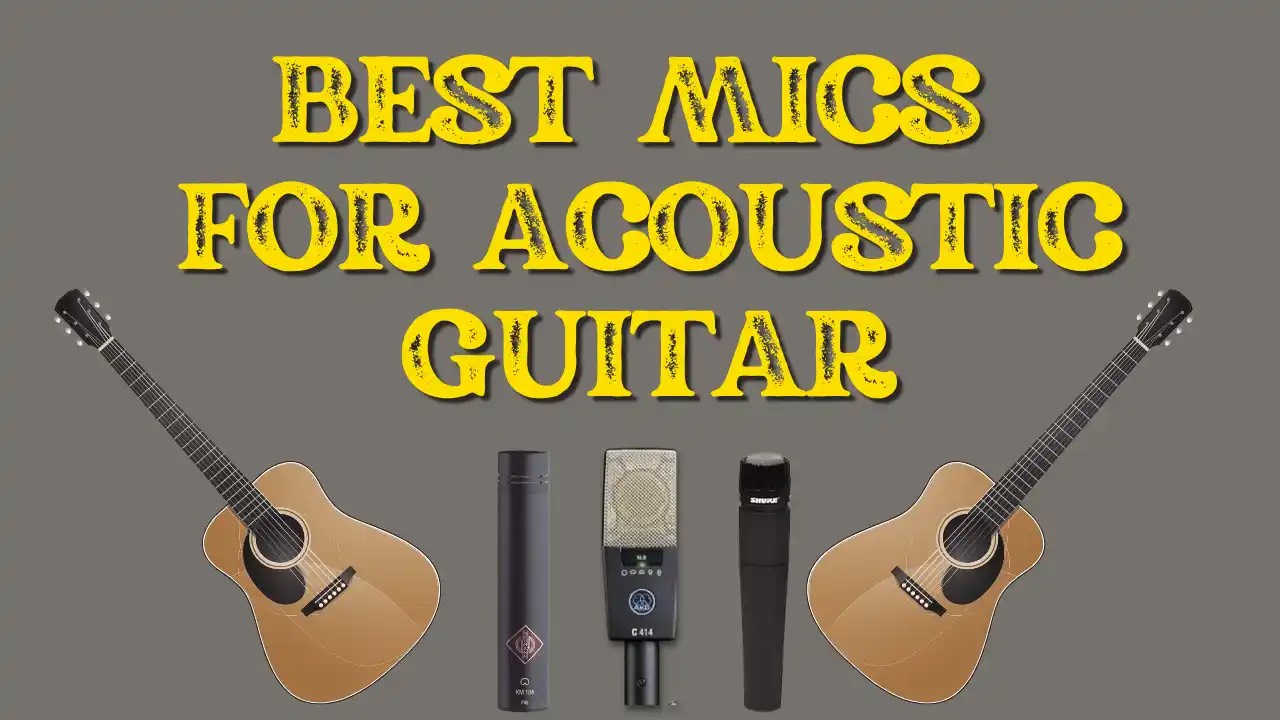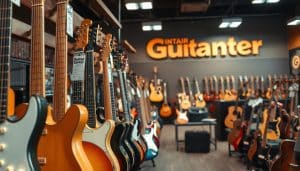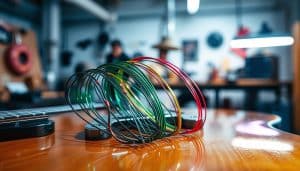For any musician or aspiring artist, finding the perfect microphone to capture the beautiful, resonant sound of an acoustic guitar is essential. With a multitude of options available, it can be overwhelming to know where to begin. That’s why we have created “The Ultimate Guide to Choosing the Best Mic for Acoustic Guitar,” a comprehensive resource to help you navigate through the vast array of microphone choices and make an informed decision. Whether you’re performing on stage or recording in the studio, this guide will equip you with the knowledge you need to find the best mic that will enhance the unique characteristics of your acoustic guitar and bring out its true brilliance.

1. Types of Microphones
1.1. Condenser Microphones
Condenser microphones are highly sensitive and capture a wide range of frequencies. They are often used in professional recording studios due to their ability to reproduce detailed and accurate sound. Condenser microphones require an external power source, known as phantom power, which is typically provided by audio interfaces or mixing consoles. They are commonly used for capturing vocals and acoustic instruments, including acoustic guitars.
1.2. Dynamic Microphones
Dynamic microphones are more rugged and can handle high sound pressure levels, making them ideal for live performances and recording situations with a lot of volume. They are less sensitive compared to condenser microphones, but they offer durability and reliability, making them a popular choice for musicians on the road. Dynamic microphones are known for their ability to handle loud sound sources, such as drums and electric guitar amplifiers.
1.3. Ribbon Microphones
Ribbon microphones are known for their smooth and vintage sound. They use a thin strip of metal, known as a ribbon, to capture sound. Ribbon microphones are delicate and require careful handling, as they can be easily damaged. They are often used in professional recording studios to capture the nuances of acoustic instruments, including acoustic guitars. Ribbon microphones have a figure-8 polar pattern, meaning they capture sound from the front and back while rejecting sound from the sides.
2. Polar Patterns
2.1. Cardioid
Cardioid is one of the most common polar patterns used in microphones. It is heart-shaped and captures sound primarily from the front while rejecting sound from the sides and rear. Cardioid microphones are ideal for recording vocals and solo acoustic performances, as they focus on the sound source while minimizing unwanted background noise.
2.2. Figure-8/Bi-directional
Figure-8 or bi-directional polar patterns capture sound equally from the front and back of the microphone while rejecting sound from the sides. This pattern is useful for recording duets or capturing sound from multiple sources in opposite directions. Figure-8 microphones are commonly used in recording studios for stereo recording techniques, such as Blumlein or Mid-Side.
2.3. Omni-directional
Omni-directional microphones capture sound from all directions equally. They do not have any directional focus and are great for capturing room ambience or in situations where you want to record multiple sound sources simultaneously. Omni-directional microphones are often used in field recording, podcasting, and capturing live performances.

3. Considerations for Recording Environment
3.1. Studio Recording
When recording in a studio, you have more control over the recording environment. This allows you to use sensitive condenser microphones to capture the nuances of the acoustic guitar. Since noise levels are kept to a minimum, the low self-noise of condenser microphones can be fully appreciated. Consider using a cardioid or figure-8 microphone for studio recordings to focus on the guitar while minimizing background noise.
3.2. Live Performance
Live performances often involve amplified sound and a higher risk of feedback. Dynamic microphones are a popular choice for live performances due to their durability and ability to handle high sound pressure levels. Choose a dynamic microphone with a cardioid polar pattern to minimize feedback and unwanted noise from stage monitors and other sound sources.
3.3. Home Recording
Home recording environments can vary, but in general, they are less controlled than professional studios. Consider using a condenser microphone for home recording if you have a quiet room and want to capture the full range and details of your acoustic guitar. For less controlled environments with more background noise, a dynamic microphone can be a suitable choice.
4. Budget
4.1. Entry-Level Options
If you are on a tight budget or just starting out, there are affordable microphones available that still offer good sound quality. Entry-level condenser microphones, such as the Audio-Technica AT2020, are excellent choices for beginners. You can also find decent dynamic microphones in this price range, such as the Shure SM58, which is known for its durability and versatility.
4.2. Mid-Range Options
In the mid-range category, you will find microphones that offer a significant improvement in sound quality compared to entry-level options. Condenser microphones like the AKG C214 or the Rode NT1 are popular choices for professional home studios. The Sennheiser e835 is a reliable dynamic microphone that is widely used in live performances.
4.3. High-End Options
If you are looking for top-notch sound quality and have a higher budget, high-end condenser microphones like the Neumann U87 or the Earthworks SR40V are the gold standard. These microphones provide exceptional detail and accuracy, making them ideal for professional recording studios. For dynamic microphones, the Electro-Voice RE20 and the Shure SM7B are often recommended for their excellent sound reproduction and versatility.

5. Match with Acoustic Guitar Type
5.1. Steel-String Acoustic
Steel-string acoustic guitars produce a bright and versatile sound. To capture the full range and brightness of the instrument, condenser microphones are often preferred. Cardioid microphones like the Audio-Technica AT4033 or the AKG C414 are popular choices for steel-string acoustic guitars, as they can accurately reproduce the natural tone and nuances of the instrument.
5.2. Classical/Nylon-String Acoustic
Classical or nylon-string guitars have a warm and mellow sound. To enhance the warm characteristics of this type of guitar, a ribbon microphone can be a great choice. Ribbon microphones like the Royer R-121 or the AEA R84 capture the smooth and rich tones of classical guitars, resulting in a natural and full-bodied sound.
5.3. Resonator Guitar
Resonator guitars are known for their distinctive sound and metallic twang. To capture the unique character of a resonator guitar, a dynamic microphone with a cardioid polar pattern can be a suitable choice. The Shure SM57 or the Sennheiser e609 are popular dynamic microphones that can accurately reproduce the punchy and twangy tones of resonator guitars.
5.4. Archtop Guitar
Archtop guitars have a rich and warm tone, with a strong emphasis on mid and low frequencies. Condenser microphones are often chosen to capture the full range of an archtop guitar’s sound. Large-diaphragm condenser microphones like the Neumann U87 or the AKG C414 are widely used in professional recordings to accurately capture the full-bodied and resonant tones of archtop guitars.
6. Sound Characteristic and Tone
6.1. Warm and Rich
If you prefer a warm and rich sound, condenser microphones are typically the best choice. These microphones capture the nuances and details of the acoustic guitar, making them ideal for capturing the warmth and richness of the instrument’s tone. Look for microphones with a smooth frequency response and a warm tonal character, such as the Neumann U87 or the AKG C414.
6.2. Bright and Clear
For a bright and clear sound, condenser microphones with extended high-frequency response are recommended. These microphones can capture the sparkling and crisp tones of the acoustic guitar. Look for microphones with a presence boost in the high-frequency range, such as the Audio-Technica AT4033 or the Rode NT1.
6.3. Balanced and Versatile
If you prefer a balanced and versatile sound, microphones with a flat frequency response are the way to go. These microphones capture the acoustic guitar’s sound accurately without adding any coloration to the tone. Look for microphones with a neutral tonal balance and a wide frequency response, such as the Earthworks SR40V or the AKG C214.

7. Connectivity and Compatibility
7.1. XLR
XLR is a common type of connector used in professional audio equipment. Most high-quality microphones, especially condenser microphones, use XLR connectors to connect to audio interfaces or mixing consoles. XLR connectors provide a balanced connection, ensuring reliable and noise-free audio transmission.
7.2. USB
USB connectivity has become popular in recent years, especially for microphones targeted towards home recording and podcasting. USB microphones are easy to use, as they can be directly connected to a computer or laptop without the need for additional audio interfaces. USB microphones are a convenient option for beginners or those recording in a home studio setup.
7.3. Other Connectivity Options
In addition to XLR and USB, there are other connectivity options available for microphones. Some microphones feature 1/4″ or 3.5mm connectors, which can be used with specific audio devices or adapters. However, it is important to note that these connectors might not provide the same level of audio quality and reliability as XLR or USB connections.
8. Accessories and Additional Features
8.1. Shock Mounts and Mounting Options
A shock mount is an essential accessory for microphones, as it reduces noise caused by vibrations and handling. Shock mounts suspend the microphone, isolating it from the stand or boom arm, and minimizing unwanted vibrations. Look for microphones that come with a compatible shock mount or invest in a separate shock mount for optimal recording quality.
8.2. Pop Filters and Windshields
Pop filters and windshields are used to minimize plosive sounds and reduce wind noise when recording vocals or acoustic instruments. A pop filter is a screen that is placed between the microphone and the sound source, preventing plosive sounds from distorting the recording. Windshields or foam covers are used to minimize wind noise when recording outdoors or in windy environments.
8.3. Pad and Low-Cut Filters
Some microphones offer additional features such as pad and low-cut filters. A pad filter attenuates the microphone’s sensitivity, allowing you to record louder sound sources without distortion. A low-cut filter, also known as a high-pass filter, removes low-frequency rumble or unwanted low-end noise from the audio signal, resulting in a cleaner recording.
8.4. Adjustable Polar Patterns
Certain microphones feature adjustable polar patterns, allowing you to change the microphone’s directionality to suit different recording scenarios. These microphones often have switches or controls that allow you to select between cardioid, figure-8, and omni-directional polar patterns. Adjustable polar patterns provide versatility, allowing you to adapt to different recording situations with a single microphone.

9. Recommendations for Specific Applications
9.1. Recording Studio
For studio recordings, condenser microphones are the preferred choice due to their ability to capture detailed and accurate sound. Consider using a large-diaphragm condenser microphone like the Neumann U87 or the AKG C414 for high-quality recordings. Pair it with a shock mount and pop filter for optimal recording quality.
9.2. Live Performance
When performing live, durability and reliability are crucial. Dynamic microphones like the Shure SM58 or the Sennheiser e835 are popular choices among musicians for their rugged build quality and ability to handle high sound pressure levels. Use a microphone stand or a wireless system for ease of movement on stage.
9.3. Busking and Street Performances
For busking and street performances, portability and durability are key factors to consider. Dynamic microphones like the Shure SM58 or the Sennheiser e835, paired with a battery-powered portable PA system, provide excellent sound quality and the ability to perform in outdoor environments.
9.4. Home Recording
For home recording, versatility and ease of use are important factors. USB microphones like the Audio-Technica AT2020USB+ or the Blue Yeti offer a plug-and-play solution, allowing you to connect directly to your computer without the need for additional audio interfaces. Pair it with a pop filter and a desktop microphone stand for optimal recording convenience.
10. Reviews and User Feedback
10.1. Professional Reviews
Professional reviews from reputable sources can provide valuable insights and comparisons between different microphone models. Look for reviews from trusted audio publications and websites, such as Sound on Sound, MusicRadar, or Recording magazine. These reviews often include detailed technical specifications, sound samples, and comparisons based on different recording scenarios.
10.2. Customer Ratings and Testimonials
Customer ratings and testimonials provide feedback based on real-world experiences from users. Websites and online retailers often feature customer reviews and ratings for specific microphone models. Pay attention to the overall rating, as well as individual comments regarding sound quality, durability, and ease of use.
10.3. Online Forums and Communities
Engaging with online forums and communities dedicated to audio recording and music production can provide valuable insights and recommendations from experienced users. Platforms like Gearslutz, Reddit’s r/audioengineering, or specific acoustic guitar forums allow you to ask questions and receive feedback from a community of like-minded individuals who have firsthand experience with various microphone models.
By considering the different types of microphones, their polar patterns, recording environments, budget limitations, acoustic guitar types, sound characteristics, connectivity options, and additional features, you can make an informed decision and choose the best microphone for your acoustic guitar needs. Remember to consult professional reviews, customer ratings, and user feedback to gain further insights into the specific models you are considering.






